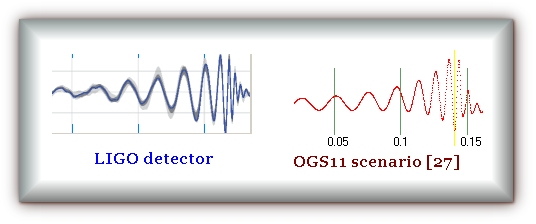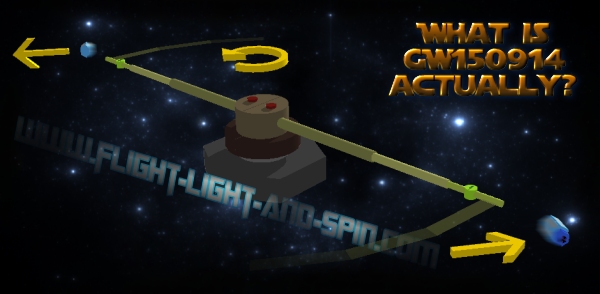|
| 9 | ||
|
Resolving
the LIGO-BOGVOS contradiction: Resolving
this paradox will require some innovation. Any further theoretical
analysis of GW150914 must start by resolving this problem. There is
clearly a missing piece of logic here. |
||
|
So I have to reluctantly conclude that if gravity is instant (because of BOGVOS), but the signal traveled at the velocity of light, then the GW150914 signal must be electromagnetic. So I had to ask the question: What is that signal? Can the LIGO group be certain that it is not a submarine from North-Korea using radio navigation off somewhere in the Southern Hemisphere? What of some strange celestial magnetic phenomenon? I felt compelled to develop a structure that would generate a pull by an electromagnetic force so that the OGS11 LIGO detector simulator would be able to ‘detect’ the desired wave-form in orbit-gravity-sim-11.exe. The really strange nature of the signal now became apparent an entire year after the GW150914 experiment was announced and my analysis began. As should be clear, a pair spiraling inwards certainly increases in frequency; but they decrease their amplitude as the difference in the forces diminishes. However, a pair spiraling outwards increases amplitude, but normally should decrease frequency if the pair are in a gravitational orbit. So the pair had to be spiraling outwards whilst increasing their rate of rotation; then reach a point of maximum distance from one another before spiraling inwards far more rapidly than they were spiraling outwards. Eventually after a year I had the correct wave-form in the OGS11 simulator:
Moreover, the rate of rotation required some astonishing variables. To start; a variable with angular velocity required another variable with angular acceleration. But the acceleration required a variable which increased the rate of acceleration. And the rate of acceleration itself required another variable which itself was accelerating. And there was even a fourth and a fifth degree of rate of acceleration. If that wasn’t enough, when the construct reached its maximum distance apart and started spiraling inwards, then the angular velocity needed to be multiplied yet again, by another 2 times in order to replicate the GW150914 signal closely. So the
amount of energy going into the system had 5 separate degrees of accumulating
acceleration; and then a final fixed rate of increase in rotation
as the pair collapsed together again. Scenario [27]
demonstrates this construct in real-time. It should be observed to
use a fixed scale for time only because it could be any distance away,
the further away it is, the stronger the pull. |
||
| . |
||
| A satellite with two rotating arms would be attached to a fixed engine. It would build up momentum by spinning at ever-increasing angular velocity. It could be fuelled by atomic energy or even ordinary sunlight if in orbit near a star. Once enough rotational velocity is acquired, two probes are jettisoned from each end of the spinning satellite. In this way the fuel is not carried with the spacecraft, and even mirrored sunlight will not wane with distance. The arms extend as rotational velocity increases with the electromagnetic signal of the spinning satellite behaving likewise. The electromagnetic wave-form will thus increase amplitude and frequency as the Astrosling reaches its zenith. Not only is this the best type of space-probe I can imagine because it does not waste fuel by carrying its own fuel, but it fits the LIGO data perfectly. So
there you have it. GW150914 is an Astrosling. |
||
Thus
ends the brief summaries of the various sections of Chapter XXIX: Analysis
of GW150914, from the book Flight, Light, and
Spin. The full article below is the entire chapter XXIX. The
next step is to download
the OGS11 LIGO simulator
although
it is probably better to read the full article first. . |
|||||
|
|||||
^ Top of Page ^

